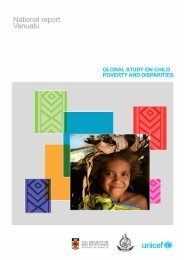A Strategic Assessment of the Children's Services Industry
A Strategic Assessment of the Children's Services Industry
A Strategic Assessment of the Children's Services Industry
- No tags were found...
Create successful ePaper yourself
Turn your PDF publications into a flip-book with our unique Google optimized e-Paper software.
STRATEGIC ASSESSMENT OF THE CHILDREN’S SERVICES INDUSTRY5.4 Gaps in ECEC demand and supply dataIt is important to move beyond aggregate information and to undertake analysis <strong>of</strong> <strong>the</strong> childcare market at a more fine-grained level. Freedman and Vicary (2008) emphasise this point,commenting on <strong>the</strong> difficulty <strong>of</strong> drawing any useful conclusions from aggregate data. Theypoint to a need for data specifically focused on particular markets, for example, local data on<strong>the</strong> children’s residence and use <strong>of</strong> services. Data on <strong>the</strong> availability <strong>of</strong> services needs to beprovided by local government area, not simply by State and Territory.Even at a macro-level, current data probably underestimates demand for child care. ABSChild care Survey estimations <strong>of</strong> parents need for additional formal care from 2002 and 2005are likely to have underestimated <strong>the</strong> needs <strong>of</strong> at least two groups. Firstly, those whocurrently used child care <strong>of</strong> one type and wished instead to use <strong>the</strong> same hours <strong>of</strong> care <strong>of</strong> adifferent type. For example, to change from using 10 hours <strong>of</strong> long day care to 10 hours <strong>of</strong>family day care. Those currently using child care were only registered as needing additionalformal care if <strong>the</strong>y needed additional hours <strong>of</strong> formal care. Secondly, those who had anongoing need for child care but had not used it in <strong>the</strong> past week or needed to use it in <strong>the</strong> lastfour weeks. For example, someone who needed child care in order to seek and takeemployment would not have registered as needing child care in <strong>the</strong> previous four weeks, as<strong>the</strong>y had not yet started work so had not yet needed child care. The 2008 Child care Surveywill examine unmet need for formal care differently and will hopefully address <strong>the</strong>seunderestimates 7 .In order for more effective market conditions to apply, information needs to be available notonly about <strong>the</strong> quantity, but also <strong>the</strong> quality <strong>of</strong> services available by type and by geographicallocation, disaggregated at <strong>the</strong> level <strong>of</strong> local government area. This is in line with <strong>the</strong>increasing recognition <strong>of</strong> <strong>the</strong> economic benefits <strong>of</strong> good quality child care (Currie, 2001;Freedman and Vicary, 2001).The need for good quality, fine-grained data is emphasised by DEEWR (2008b: 20).DEEWR operates <strong>the</strong> Access Hotline which provides information to parents about child careavailability. It has been difficult to collect reliable data which indicates where <strong>the</strong>re is unmetdemand and where <strong>the</strong>re is an oversupply <strong>of</strong> places. Detailed local information about demandand supply would contribute to <strong>the</strong> operation <strong>of</strong> this service for parents.The availability <strong>of</strong> quality data will be aided by <strong>the</strong> development by <strong>the</strong> Australian Institute <strong>of</strong>Health and Welfare <strong>of</strong> a <strong>Children's</strong> <strong>Services</strong> National Minimum Data Set. This was developedby <strong>the</strong> <strong>Children's</strong> <strong>Services</strong> Data Working Group to provide "comprehensive" data on childcare and preschool services. The data set is yet to be implemented.7 Hea<strong>the</strong>r Crawford, Australian Bureau <strong>of</strong> Statistics, personal communication, 18 July 2008.52
















